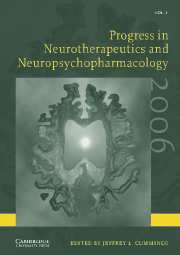Book contents
- Frontmatter
- Contents
- Preface
- Contributors
- Introduction to neurotherapeutics and neuropsychopharmacology
- Rivastigmine in the treatment of dementia associated with Parkinson's disease: a randomized, double-blind, placebo-controlled study
- Modafinil for the treatment of fatigue in multiple sclerosis
- Radiotherapy with concurrent and adjuvant temozolomide: a new standard of care for glioblastoma multiforme
- Treating migraine attacks ASAP: concept and methodological issues
- Early phase trials of minocycline in amyotrophic lateral sclerosis
- Creatine as a potential treatment for amyotrophic lateral sclerosis
- AVP-923 as a novel treatment for pseudobulbar affect in ALS
- Liquid fluoxetine versus placebo for repetitive behaviors in childhood autism
- Testing multiple novel mechanisms for treating schizophrenia in a single trial
- Selegiline in the treatment of negative symptoms of schizophrenia
- Analysis of the cognitive enhancing effects of modafinil in schizophrenia
- Efficacy and tolerability of ziprasidone and olanzapine in acutely ill inpatients with schizophrenia or schizoaffective disorder: results of a double-blind, six-week study, with a six-month, double-blind, continuation phase
- Subject index
- Author index
Testing multiple novel mechanisms for treating schizophrenia in a single trial
Published online by Cambridge University Press: 22 March 2010
- Frontmatter
- Contents
- Preface
- Contributors
- Introduction to neurotherapeutics and neuropsychopharmacology
- Rivastigmine in the treatment of dementia associated with Parkinson's disease: a randomized, double-blind, placebo-controlled study
- Modafinil for the treatment of fatigue in multiple sclerosis
- Radiotherapy with concurrent and adjuvant temozolomide: a new standard of care for glioblastoma multiforme
- Treating migraine attacks ASAP: concept and methodological issues
- Early phase trials of minocycline in amyotrophic lateral sclerosis
- Creatine as a potential treatment for amyotrophic lateral sclerosis
- AVP-923 as a novel treatment for pseudobulbar affect in ALS
- Liquid fluoxetine versus placebo for repetitive behaviors in childhood autism
- Testing multiple novel mechanisms for treating schizophrenia in a single trial
- Selegiline in the treatment of negative symptoms of schizophrenia
- Analysis of the cognitive enhancing effects of modafinil in schizophrenia
- Efficacy and tolerability of ziprasidone and olanzapine in acutely ill inpatients with schizophrenia or schizoaffective disorder: results of a double-blind, six-week study, with a six-month, double-blind, continuation phase
- Subject index
- Author index
Summary
Key words: Schizophrenia; clinical trial; osanetrant; NK3 antagonist; 5-HT2A/C antagonist; central cannabinoid antagonist; neurotensin antagonist.
Introduction
Schizophrenia is one of the most common and severe forms of mental illness. Its major features include psychosis, cognitive impairment, negative symptoms, and a high rate of suicide, the latter mainly due to depression and hopelessness. The treatment of schizophrenia in much of the world is largely pharmacologic, with psychosocial support and cognitive rehabilitation quite useful, but often not provided because of cost. Prior to the reintroduction of clozapine in 1990 in the USA, the major pharmacologic treatment for schizophrenia was dopamine D2 receptor blockers, such as haloperidol, whose chief side-effects were mechanism-based blockade of D2 receptors in the dorsal striatum, leading to a variety of acute and chronic extrapyramidal side-effects (EPS) (e.g. tardive dyskinesia). The demonstration that clozapine was more efficacious in a subgroup of patients and produced fewer EPS of all types (Meltzer, 1997; Kane et al., 1988), led to search for other drugs which were clozapine like but did not produce agranulocytosis, the side-effect which limited clozapine to use in treatment-resistant patients. The ensuing decade produced a variety of clozapine-like drugs, based on the principle of some dopamine D2 receptor blockade, accompanied by serotonin (5-HT)2A or 5-HT1A, partial agonism, or both (Meltzer, 2001). The introduction of olanzapine, quetiapine, risperidone, ziprasidone, and zotepine has led to their replacing the D2 blockers as first-line therapy. Recently, a partial dopamine D2/D3 agonist mechanism accompanied by 5-HT1A partial agonism, and 5-HT2A antagonism (i.e. aripiprazole) has been found to have similar advantages to drugs like risperidone.
- Type
- Chapter
- Information
- Progress in Neurotherapeutics and Neuropsychopharmacology , pp. 115 - 120Publisher: Cambridge University PressPrint publication year: 2006
- 2
- Cited by

